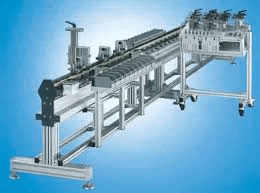-
Laser Cladding
Laser cladding is an additive manufacturing process that utilizes a laser to metallurgically bond performance coatings to a product’s base material.
Benefits:
The process uses the laser to create a melt pool of the base material. The coating material is introduced into this melt pool in either powder or wire form.
Best Used For:
A wide range of cladding applications; including small footprint applications.
View Details -
LIMISTAT
Limistat is a series of electrically conductive rubber covered rollers designed to aid in dissipating static produced by webs.
Benefits:
Reduce static build-up in high speed web applications.
Best Used For:
Limistat functions best in high-speed webs that suffer from static electricity buildup.
View Details -
Liquid Dispersion
Liquid dispersion is a polymer coating process technique used in a wide variety of applications.
Benefits:
Polymer applied coatings.
Best Used For:
Wide range of polymer coating applications.
View Details -
Low Friction
Reduce the cleanup and buildup of such materials as starches, paints, adhesives, latex, rubber, food, paper, ice, sugar, resins, tapes, inks.
Benefits:
Extremely wear resistant and long lasting.
Best Used For:
Hard base onto your part and then impregnate one of our Low COF release agents into that coating.
View Details -
Machine Frame
We deisgn, engineer and apply coatings to machine frames for wear and corrosion resistance to extend their life spans.
Benefits:
Service is provided on-site.
Best Used For:
A wide range of industries and applications
View Details -
Machined Crowns
Roller crowning is intended to ensure proper web alignment and helps minimize the effects of deflection. Materials include several types of aluminum and steel.
Benefits:
Minimize the effects of deflection.
Best Used For:
A wide variety of applications.
View Details -
Mag. Particle Test
Magnetic particle Inspection (MPI) is a non-destructive testing (NDT) test for detecting surface and subsurface discontinuities in materials such as iron, nickel, cobalt, and some of their alloys.
Benefits:
Ensures product quality and uniformity.
Best Used For:
Often used as a quality verification process.
View Details -
Magna Flux Test
A magna flux test is a non-destructive testing (NDT) process for detecting surface, and subsurface, discontinuities in materials such as: iron, nickel, cobalt, and some of their alloys.
Benefits:
This process puts a magnetic field into the piece and the piece can be magnetized by direct or indirect magnetization.
Best Used For:
Often used as a quality verification process.
View Details -
-
Media Immersion Testing
Application media immersion testing is one of the services we offer as part of our Chemical Resistance Property Testing.
Benefits:
Chemical Resistance Property Testing.
Best Used For:
Wide range of problem solving applications and analysis.
View Details -
MIG Welding
Gas metal arc welding (GMAW), sometimes referred (MIG) welding or metal active gas (MAG) welding, is a welding process which heats the workpiece metal(s), causing them to melt and join.
Benefits:
A welding process in which an electric arc forms between a consumable wire electrode and the workpiece metal(s), which heats the workpiece metal(s), causing them to melt and join.
Best Used For:
A wide variety of welding applications.
View Details -
Mirror Finishing
Chrome plating is used where a “mirror” finish is needed.
Benefits:
Mirror finishing is a very smooth surface and can either decrease or increase web/roller friction.
Best Used For:
A wide variety of applications.
View Details
Showing 61–90 of 202 results































